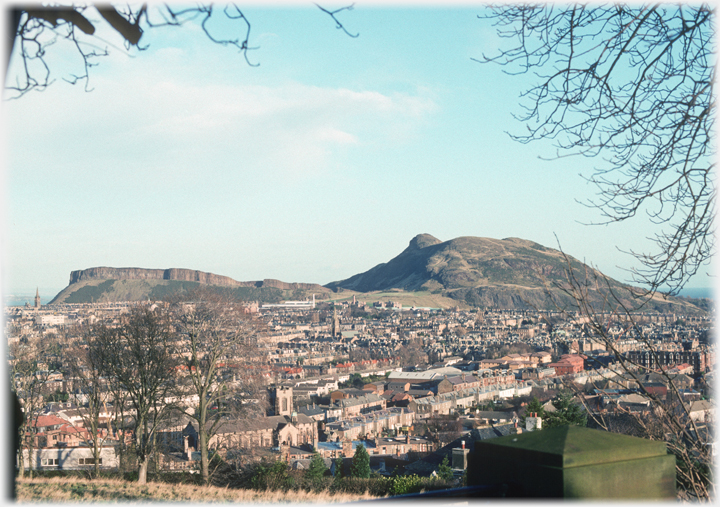 Arthur's Seat and Salisbury Crags (to the left) dominate Edinburgh, forming a striking feature of the landscape for 30 miles (50 kilometres) in all directions
Previous pages have treated
Edinburgh Castle
as the city's centre and focus, but that is not how many citizens see their home. For them Arthur's Seat performs a pivotal role. The origins of the name are debated inconclusively, but we do know that the area of Arthur's Seat, Salisbury Crags and Duddingston, which had been a royal hunting preserve for some 400 years was, in 1541, enclosed by James V with a wall, and designated a Royal Park. Ownership is now, as so often in Scotland, hidden and complex. However, the public has long enjoyed this accessible and special place. It affords views that are surely unrivalled for their combination of a rich city-scape, estuary, open sea and countryside stretching to the hills. This page offers some views of, and from, the hill taken over a period of 40 years - accordingly the quality varies somewhat. A little information on geology and history is included in the captions.
Arthur's Seat and Salisbury Crags (to the left) dominate Edinburgh, forming a striking feature of the landscape for 30 miles (50 kilometres) in all directions
Previous pages have treated
Edinburgh Castle
as the city's centre and focus, but that is not how many citizens see their home. For them Arthur's Seat performs a pivotal role. The origins of the name are debated inconclusively, but we do know that the area of Arthur's Seat, Salisbury Crags and Duddingston, which had been a royal hunting preserve for some 400 years was, in 1541, enclosed by James V with a wall, and designated a Royal Park. Ownership is now, as so often in Scotland, hidden and complex. However, the public has long enjoyed this accessible and special place. It affords views that are surely unrivalled for their combination of a rich city-scape, estuary, open sea and countryside stretching to the hills. This page offers some views of, and from, the hill taken over a period of 40 years - accordingly the quality varies somewhat. A little information on geology and history is included in the captions.
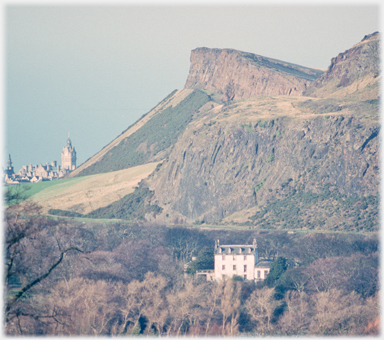 Opulence, in the form of Prestonfield House and the tower of the North British Hotel, here appear separated by Salisbury Crags
Opulence, in the form of Prestonfield House and the tower of the North British Hotel, here appear separated by Salisbury Crags
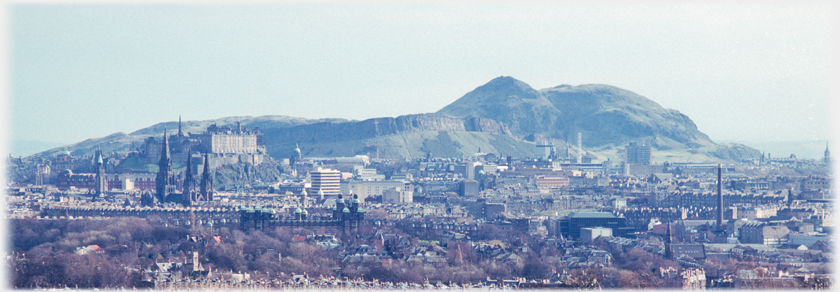 From the west a view of Arthur's Seat includes the Castle and the three spired cathedral. The hill was formed about 340 million years ago by a series of volcanoes, some very explosive. The present hilltop would have been deep in the centre of these, weathering and ice flows have created the present appearance
From the west a view of Arthur's Seat includes the Castle and the three spired cathedral. The hill was formed about 340 million years ago by a series of volcanoes, some very explosive. The present hilltop would have been deep in the centre of these, weathering and ice flows have created the present appearance
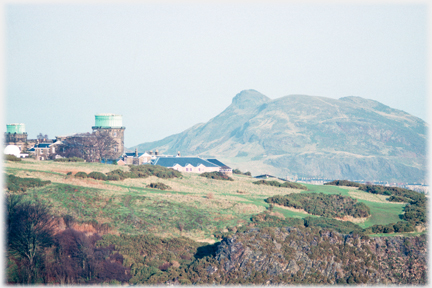 Arthur's Seat from beside the Royal Observatory which moved here, near the King's Buildings, from Calton Hill in the late 1800s
Arthur's Seat from beside the Royal Observatory which moved here, near the King's Buildings, from Calton Hill in the late 1800s
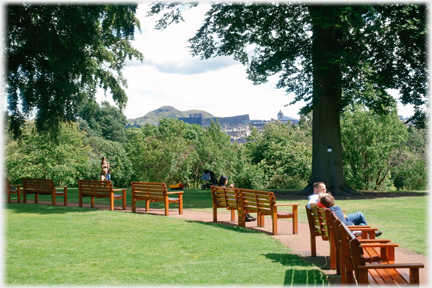 A wide angle lens emphasises the seats in the grounds of the Botanic Gardens from where a fine cityscape includes Arthur's Seat
A wide angle lens emphasises the seats in the grounds of the Botanic Gardens from where a fine cityscape includes Arthur's Seat
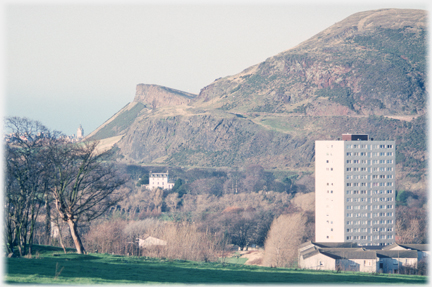 To balance the opulence, indicated in the shot higher up the page, here a wider angle includes part of the Craigmillar housing scheme
To balance the opulence, indicated in the shot higher up the page, here a wider angle includes part of the Craigmillar housing scheme
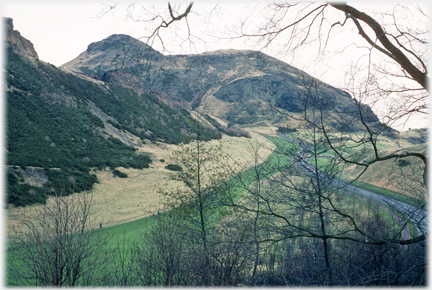 The grass area below the Crags is adjacent to the Dumbiedykes scheme. The grass here providing a valuable outdoor space - less enticing in the winter!
The grass area below the Crags is adjacent to the Dumbiedykes scheme. The grass here providing a valuable outdoor space - less enticing in the winter!
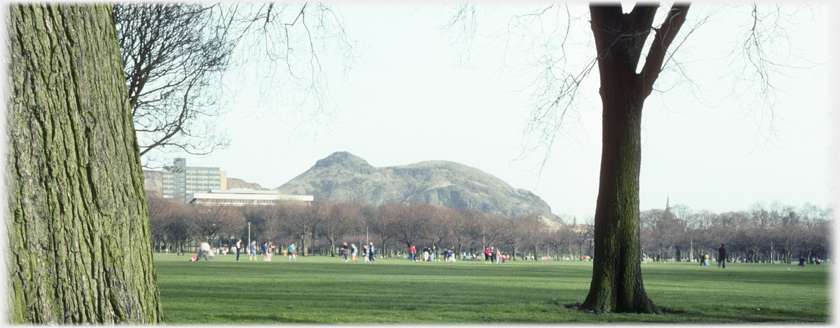 Seen from the Meadows, with university buildings to the left, the common 'crouching lion' sobriquet is barely discernible. Arthur's Seat is just over 800 feet high (250 metres) raising it well above all ground within 10 miles or so. The Royal Park, of which it is the centre piece, extends to some 640 acres (260 ha)
Seen from the Meadows, with university buildings to the left, the common 'crouching lion' sobriquet is barely discernible. Arthur's Seat is just over 800 feet high (250 metres) raising it well above all ground within 10 miles or so. The Royal Park, of which it is the centre piece, extends to some 640 acres (260 ha)
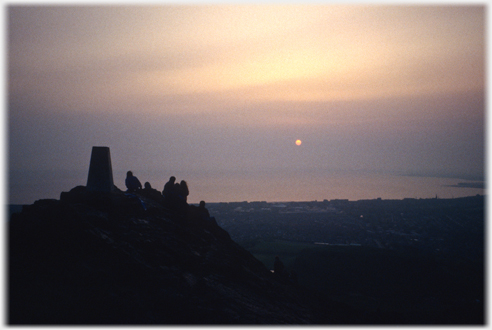 Sun rising from a cloud bank over the sea as summer night owls go home, taking a detour via the cairn on the summit of Arthur's Seat
Sun rising from a cloud bank over the sea as summer night owls go home, taking a detour via the cairn on the summit of Arthur's Seat
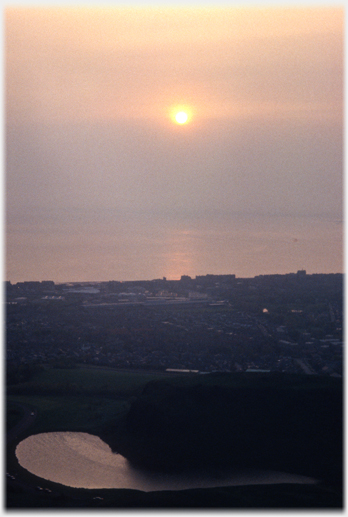 The sun climbs to show the buildings of Portobello and the water of Dunsapie Loch
The sun climbs to show the buildings of Portobello and the water of Dunsapie Loch
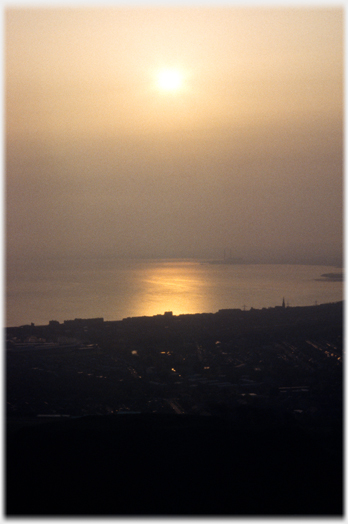 The cold light of dawn warms up the sea...
The cold light of dawn warms up the sea...
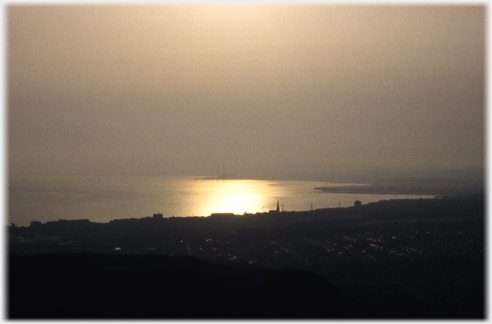 ...and the coastline - with Cockenzie power station just visible
...and the coastline - with Cockenzie power station just visible
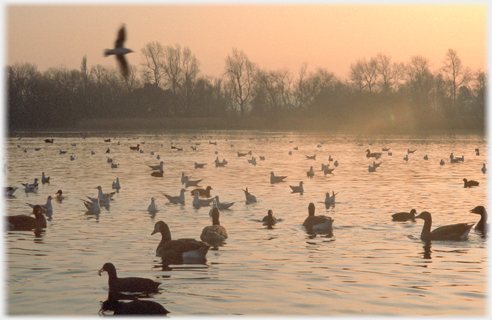 Duddingston Loch and its winter inhabitants
Duddingston Loch and its winter inhabitants
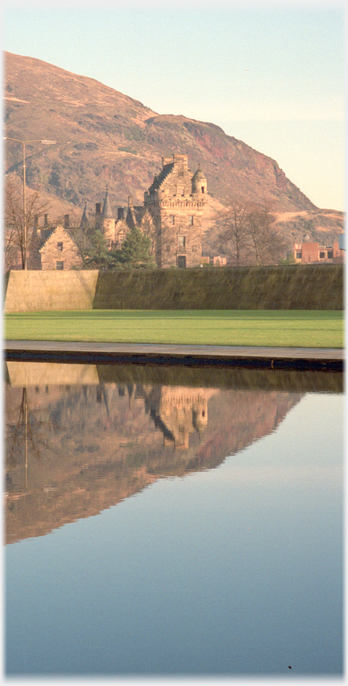 ...(above) the near-by artificial pool at the Scottish Widows building which reflects St Leonard's Hall and the rump of Arthur's Seat
...(above) the near-by artificial pool at the Scottish Widows building which reflects St Leonard's Hall and the rump of Arthur's Seat
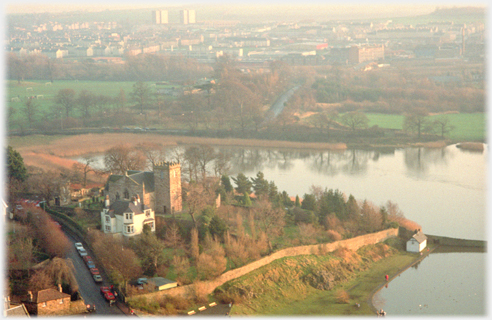 Looking down on Duddingston Kirk and Loch from the hill. A view of water in the Park is also supplied by Dunsapie and St. Margaret's Lochs, and...
Looking down on Duddingston Kirk and Loch from the hill. A view of water in the Park is also supplied by Dunsapie and St. Margaret's Lochs, and...
 A full panorama taken from Blackford Hill to the south west of the city. The Crags are brought into prominence from this angle. They are younger than the hill, being formed from underground volcanic material that could not make it to the surface, so trapped, it spread out, this happened about 320 million years ago, later it tilted 90 degrees to give the wall effect we now see
A full panorama taken from Blackford Hill to the south west of the city. The Crags are brought into prominence from this angle. They are younger than the hill, being formed from underground volcanic material that could not make it to the surface, so trapped, it spread out, this happened about 320 million years ago, later it tilted 90 degrees to give the wall effect we now see
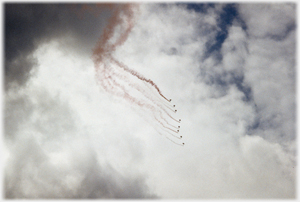 Such an open space, as the Royal Park, allows displays of all kinds
Such an open space, as the Royal Park, allows displays of all kinds
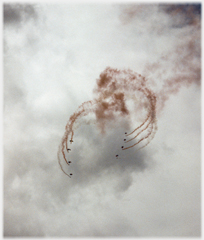 These sky divers end their performance in the Park...
These sky divers end their performance in the Park...
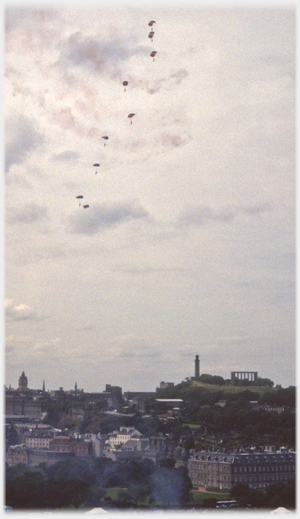
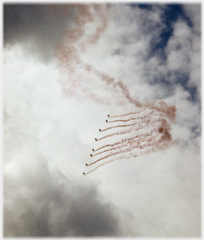
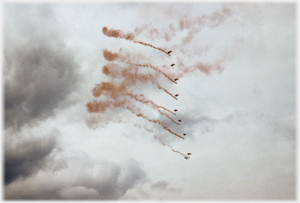
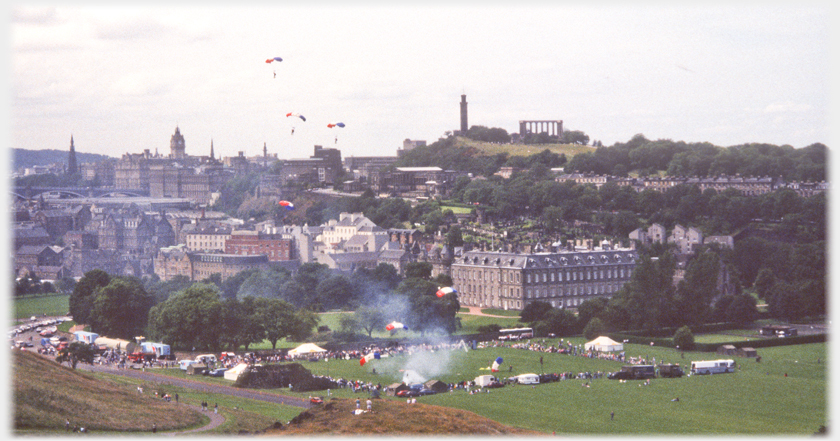 ...and with extraordinary accuracy hit the space provided adjacent to Holyrood Palace. Above which sits calton Hill, and to the left of the photograph the North British Hotel
...and with extraordinary accuracy hit the space provided adjacent to Holyrood Palace. Above which sits calton Hill, and to the left of the photograph the North British Hotel
(now sadly only another 'Balmoral')
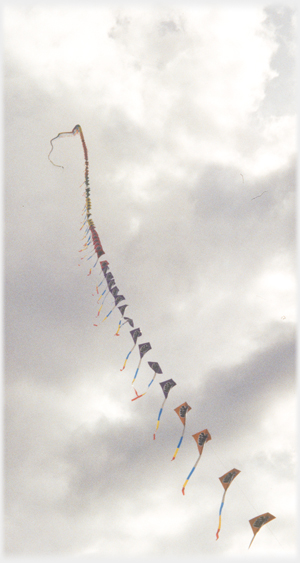 Kite flying in the Park is regularly fashionable; surely this is prize winning
Kite flying in the Park is regularly fashionable; surely this is prize winning
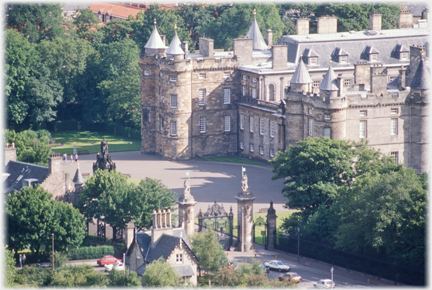 The main entrance of the Park's Royal Residence
The main entrance of the Park's Royal Residence
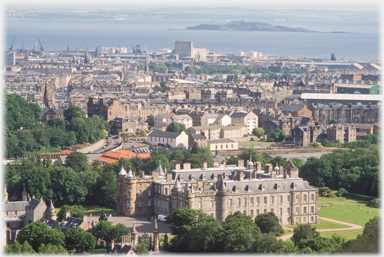 Holyrood Palace sits at the north west of the Park. Here Leith and Inchkeith are seen beyond the Palace
Holyrood Palace sits at the north west of the Park. Here Leith and Inchkeith are seen beyond the Palace
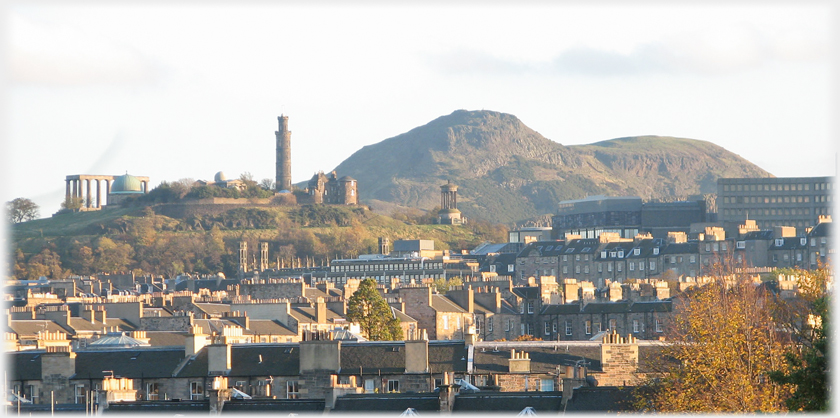 A final long shot of evening light on the hill, with a rather brutalist late 60s St. James Centre
A final long shot of evening light on the hill, with a rather brutalist late 60s St. James Centre
muscling in to the right. Happily its short mediocre life has now ended.
The picture foregrounds Calton Hill, the subject of the next page Trailers...
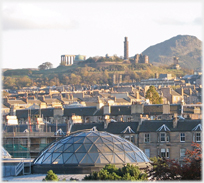 The next page
in Picture Posting is about Edinburgh's Calton Hill and the Beltane Festival.
The next page
in Picture Posting is about Edinburgh's Calton Hill and the Beltane Festival.
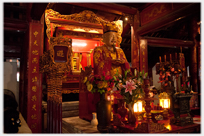 The next page
of the Mosaic Section is headed 'Hexagrams'.
The next page
of the Mosaic Section is headed 'Hexagrams'.
Or go to the contents Go to the contents of the Mosaic Section. of the Mosaic Section.

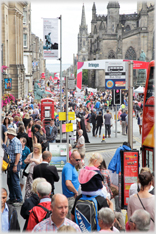
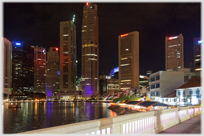 How different could the heart of two capitals be - Singapore
How different could the heart of two capitals be - Singapore
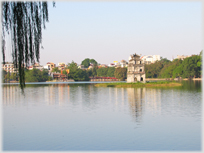 Another capital with a very distinctive heart - Hà Nội
Another capital with a very distinctive heart - Hà Nội
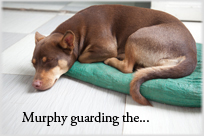 ...guide to this site
...guide to this site